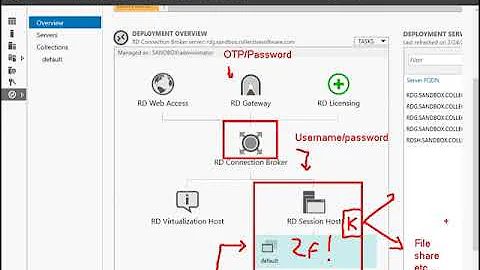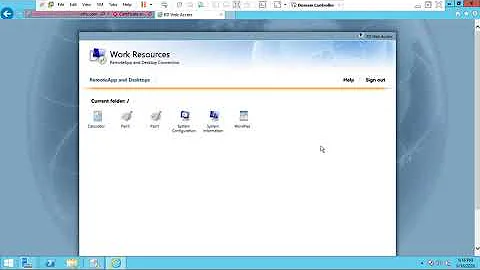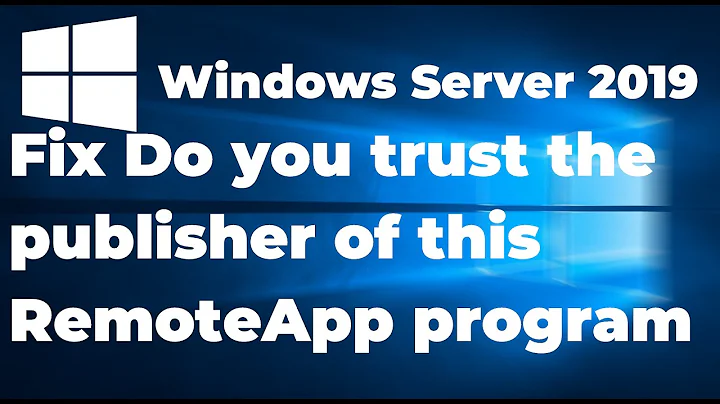Allow only RemoteApp, not Remote Desktop
Solution 1
There isn't an "officially sanctioned" way to do this because, fundamentally, TS RemoteApp functionality is just leveraging existing Remote Desktop code. You could do something silly like use Group Policy to set the user's shell to be "logoff.exe" such that if they attempted to access the machine's desktop they'd be immediately logged-off. Any application that uses a common "File / Open" dialog, though, can be used to get a command prompt or other programs open on the server's desktop.
You're better off making sure that you follow the principle of least privilege and give your TS RemoteApp users as few rights as they need to run the intended software. If they do end up on the server computer's desktop their restricted rights should prevent them from doing anything damaging to the server computer.
Solution 2
It is better to use "Application control policy" in the security settings just to allow only necessary applications or scripts if you use Windows 7 or Windows 2008 R2
Solution 3
This is what I have done to lock the Desktop to only be accessible for server administrators and a named AD group. Users that are not member of the given AD group will get a message telling them to use the RDWeb and not the Desktop/standard mstsc.
- Create a vbscript and put it in a folder on the server that all users can read+execute
Add the following line to
%windir%\system32\USRLOGON.CMDcscript <sourcefolder>\DesktopUserCheck.vbs
The vbscript code (please add your personal info in the below <> entries)
'Script created by Tord Bergset, Jan 2014
'This script is called from the file called C:\Windows\System32\USRLOGON.CMD
'The script check if a user logging on to the server desktop is a allowed to do this.
'The string called StrGroupName controls the access group to check for.
'AD group used for this script = "G WTS Grant Desktop Access"
'---------------------------------------------------------------------------------------
Const strComputer = "."
Const EWX_LOGOFF = 0
Dim objShell, objWMIService, colProcessList, objNetwork, StrGroupName, strUsername, strUserIsMember, strUserFullName
Set objShell = WScript.CreateObject ("WScript.Shell")
Set objWMIService = GetObject("winmgmts:" & "{impersonationLevel=impersonate}!\\" & strComputer & "\root\cimv2")
Set colProcessList = objWMIService.ExecQuery("SELECT * FROM Win32_Process WHERE Name = 'userinit.exe'")
Set objNetwork = CreateObject("Wscript.Network")
strUsername = EnvString("username")
' Mention any AD Group Name Here. Also works for Domain Admins, Enterprise Admins etc.
' -------------------------------------------------------------------------------------
StrGroupName = "G WTS Grant Desktop Access"
' -------------------------------------------------------------------------------------
If IsAdmin = 0 Then wscript.Quit
CheckADGroupMembership()
If strUserIsMember = "YES" Then
' Do something here if user is a member of the group
'MsgBox "Is member"
Wscript.Quit
Else
' Do something here if user is NOT a member of the group
'MsgBox "Is not member"
For Each objProcess in colProcessList
MsgBox "You (" & strUsername & " ) are not allowed to log in to the server desktop." & VBLF & "Please connect through the Remote Desktop Web Page (RDWeb):" & VBLF & VBLF & "<rdweb server address>", vbExclamation + vbSystemModal, strUsername & " - Access Denied !"
objShell.run "logoff"
WScript.Quit
Next
End If
Wscript.Quit
' *****************************************************
'This function checks to see if the logged on user has local admin rights
Function IsAdmin()
With CreateObject("Wscript.Shell")
IsAdmin = .Run("%comspec% /c OPENFILES > nul", 0, True)
End With
End Function
' *****************************************************
'This function checks to see if the passed group name contains the current user as a member. Returns True or False
Function IsMember(groupName)
If IsEmpty(groupListD) then
Set groupListD = CreateObject("Scripting.Dictionary")
groupListD.CompareMode = TextCompare
ADSPath = EnvString("userdomain") & "/" & EnvString("username")
Set userPath = GetObject("WinNT://" & ADSPath & ",user")
For Each listGroup in userPath.Groups
groupListD.Add listGroup.Name, "-"
Next
End if
IsMember = CBool(groupListD.Exists(groupName))
End Function
' *****************************************************
'This function returns a particular environment variable's value.
' for example, if you use EnvString("username"), it would return the value of %username%.
Function EnvString(variable)
variable = "%" & variable & "%"
EnvString = objShell.ExpandEnvironmentStrings(variable)
End Function
' *****************************************************
Sub CheckADGroupMembership()
' =============================================================
' List All Members of a Group; Including Nested Members
' =============================================================
Dim ObjRootDSE, ObjConn, ObjRS, ObjCustom
Dim StrDomainName, StrGroupName, StrSQL
Dim StrGroupDN, StrEmptySpace
strUserIsMember = ""
Set ObjRootDSE = GetObject("LDAP://RootDSE")
StrDomainName = Trim(ObjRootDSE.Get("DefaultNamingContext"))
Set ObjRootDSE = Nothing
StrSQL = "Select ADsPath From 'LDAP://" & StrDomainName & "' Where ObjectCategory = 'Group' AND Name = '" & StrGroupName & "'"
Set ObjConn = CreateObject("ADODB.Connection")
ObjConn.Provider = "ADsDSOObject": ObjConn.Open "Active Directory Provider"
Set ObjRS = CreateObject("ADODB.Recordset")
ObjRS.Open StrSQL, ObjConn
If ObjRS.EOF Then
'WScript.Echo VbCrLf & "This Group: " & StrGroupName & " does not exist in Active Directory"
End If
If Not ObjRS.EOF Then
WScript.Echo vbNullString
ObjRS.MoveLast: ObjRS.MoveFirst
'WScript.Echo "Total No of Groups Found: " & ObjRS.RecordCount
'WScript.Echo "List of Members In " & StrGroupName & " are: " & VbCrLf
While Not ObjRS.EOF
StrGroupDN = Trim(ObjRS.Fields("ADsPath").Value)
Set ObjCustom = CreateObject("Scripting.Dictionary")
StrEmptySpace = " "
GetAllNestedMembers StrGroupDN, StrEmptySpace, ObjCustom
Set ObjCustom = Nothing
ObjRS.MoveNext
Wend
End If
ObjRS.Close: Set ObjRS = Nothing
ObjConn.Close: Set ObjConn = Nothing
End Sub
Private Function GetAllNestedMembers (StrGroupADsPath, StrEmptySpace, ObjCustom)
Dim ObjGroup, ObjMember
Set ObjGroup = GetObject(StrGroupADsPath)
For Each ObjMember In ObjGroup.Members
'WScript.Echo Trim(ObjMember.CN) & " --- " & Trim(ObjMember.DisplayName) & " (" & Trim(ObjMember.Class) & ")" & " (" & Trim(ObjMember.sAMAccountName) & ")"
strThisUser = Trim(ObjMember.sAMAccountName)
If lCase(strUsername) = lCase(strThisUser) Then
strUserIsMember = "YES"
strUserFullName = Trim(ObjMember.DisplayName)
Exit Function
End If
If Strcomp(Trim(ObjMember.Class), "Group", vbTextCompare) = 0 Then
If ObjCustom.Exists(ObjMember.ADsPath) Then
'WScript.Echo StrEmptySpace & " -- Already Checked Group-Member " & "(Stopping Here To Escape Loop)"
Else
ObjCustom.Add ObjMember.ADsPath, 1
GetFromHere ObjMember.ADsPath, StrEmptySpace & " ", ObjCustom
End If
End If
Next
End Function
Private Sub GetFromHere(StrGroupADsPath, StrEmptySpace, ObjCustom)
Dim ObjThisGroup, ObjThisMember
Set ObjThisGroup = GetObject(StrGroupADsPath)
'WScript.Echo vbNullString
'WScript.Echo " ** Members of this Group are:"
For Each ObjThisMember In ObjThisGroup.Members
'WScript.Echo " >> " & Trim(ObjThisMember.CN) & " --- " & Trim(ObjThisMember.DisplayName) & " (" & Trim(ObjThisMember.Class) & ")" & " (" & Trim(ObjThisMember.sAMAccountName) & ")"
strThisUser = Trim(ObjThisMember.sAMAccountName)
If lCase(strUsername) = lCase(strThisUser) Then
strUserIsMember = "YES"
strUserFullName = Trim(ObjThisMember.DisplayName)
Exit Sub
End If
Next
'WScript.Echo vbNullString
End Sub
Related videos on Youtube
Victor
Updated on September 17, 2022Comments
-
Victor almost 2 years
I found the following question, with a similar premise, however the answer to the question, was the question rephrased as a statement!
RemoteApp Prevent User from Running Remote Desktop
How do I allow RemoteApp but disallow Remote Desktop? In order to allow remote app, I'm seemingly having to add the users to the "Remote Desktop Users" group. This allows Remote Desktop.
I tried using the "TS Web Access Computers" group, however this does not give them the authority to run RemoteApp.
Where is the configuration to disable Remote Desktop, while leaving RemoteApp capabilities intact?
-
 Philip about 14 yearsRemoteApp is still TS/RDS; you still have to secure the server just the same.
Philip about 14 yearsRemoteApp is still TS/RDS; you still have to secure the server just the same. -
Victor about 14 yearsAgreed, though the premise of our service, is they are only allowed to use the Application. They are not given a full login to desktop to reduce overhead on the system. If they work around it like Evan mentions, then we can deal with that case by case. This is a resources issue, not a security issue tough.
-
-
Victor about 14 yearsGood to know, the software is our own, and we are providing customers a way to run it without having their own server. However we are attempting to restrict them down to simply using the application. Will attempt that idea and see how it goes.
-
Victor about 14 yearsWhere is the policy for this located at? Can I do this in the Local Security Policy for the server hosting these applications? If I need to do this at a domain level, need to bring in the owner of the company and walk him through it.
-
Zoredache about 14 years@Aequitarum Custos, I believe he was talking about
User Configuration/Policies/Administrative Templates/System/Custom User Interface -
Hecter about 14 yearsDon't forget to set software restriction policies that allow them to run only what you are expecting them to run. (+1 for setting the shell to logoff.exe: I've done the same & recommend it)
-
Hecter about 14 years@Aequitarum No, you don't need to do it at the domain level. If you want to edit Group Policies locally for one machine only, just run gpedit.msc.
-
Spence about 14 yearsSoftware restriction policy would be a lot less hackish than changing the shell, but denying access to Explorer, I would surmise, is going to be problematic.




